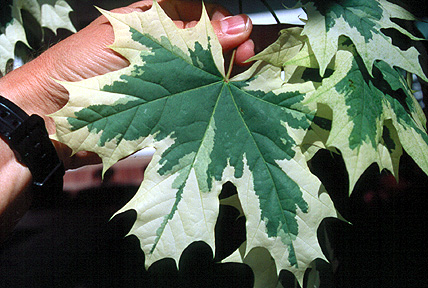Norway Maple
Acer platanoides
Family: Aceraceae or Maple
Leaves: Opposite; simple; 4" to 7" wide and long; deciduous; typically palmately 5-lobed; lobes sharply pointed; somewhat serrate margin; bright green to dark purple, depending on variety; turning bright yellow or yellow-orange in fall; petiole 2" to 4" long, as long or longer than the leaf blade; milky sap is visible when petiole broken or removed from stem (this may disappear late in the summer).
Twigs/buds: Twigs stout; olive-brown; glabrous; leaf scars meet. Terminal bud 1/4" to 3/8" long, rounded, green-red to red, glabrous; lateral buds smaller.
Flowers/fruit: Flowers dioecious (some are perfect); yellow-green to yellow and fairly showy; 1/4" to nearly 1/2" diameter; appearing in spring as leaves expand. Fruit a samara; 2 wide-spread wings, 1-1/2" to 2" long; matures in September-October.
Bark: Smooth and gray-brown on young stems; furrowed on older stems.
Wood: Little known in U.S.; presumably similar to sugar maple.
General: Native to Europe from Norway south, though widely planted and occasionally has escaped cultivation in parts of the U.S., including Utah. Intermediate shade tolerance.
Landscape Use: This is a good tree that has become over-planted in parts of Utah. It tolerates a wide range of environmental conditions, though leaves will scorch on very hot, dry sites. Many varieties are available with dark purple to bright green leaf colors. However, there are also green-leaved varieties. Honeydew from aphids can be a nuisance in some years, though the tree is rarely harmed. Its most attractive features are its strong wide crown and its good summer and fall color. Zones 3-8.







